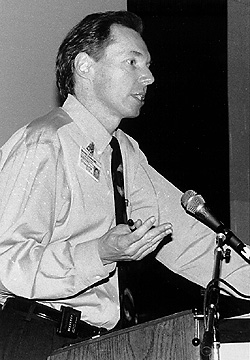
Dr. Bernard Hudson spoke at the recent Psychiatric Hospital seminar for state educators. (photo by Paul Hightower)
Seminar educates state educators on spotting teens at risk for violence
When faculty and staff at the Psychiatric Hospital at Vanderbilt sent out flyers to area educators and school counselors offering a one-day seminar on violent behavior and substance abuse in school-age children, they expected about 50 responses. They got more than 200.
Last week's conference, attended by 210 educators from across the state, was PHV's response to the shootings at Columbine High School and other recent school-based tragedies. Vanderbilt psychiatrists and counselors instructed the group on the warning signs, identification and intervention techniques for teens at risk for violence and drug abuse.
Dr. Bernard O. Hudson, assistant professor of Psychiatry, told the group that violence in schools is not the only type of violence that puts teens at risk. The suicide rate for teenagers has quadrupled since the 1950s.
"Violence is not necessarily unique to the United States but what is unique is our view that we should be immune," Hudson said.
It is especially important for educators to be aware of potential warning signs since parents and teachers may see problems in teenagers in a different way, Hudson said.
And the internet has added a new worry for those who are familiar with troubled youth.
"The fastest growing type of sexual addiction is happening from 9 a.m. until 5 p.m. on online pornography sites," he said. "Parents who have no filtered access for the family's internet connection are asking for trouble, particularly those with adolescent boys."
Hudson talked about well-known serial killers such as Ted Bundy and Richard Speck. Problems were developing and becoming obvious to the people who knew them as early as adolescence, he said.
Hudson said that even though school violence seems to be increasing, schools remain one of the safer areas of society.
"There are 53 million students in school in this country at any one time. Your chances of being killed at school are one in a million."
Nevertheless, it's a risk.
Educators must be alert and watching for potential signs of trouble, Hudson said. It's important, for example, to find out from a troubled teen whether there's a gun in the home.
"They may tell you there's a gun in the home, but it's locked up, unassembled or has no ammunition. If a student gives you any of those three qualifiers, they don't mean a thing."
Hudson gave the group some warning signs to help spot potential troubled youth. They include:
o history of tantrums and uncontrollable angry outbursts;
o tendency for name calling, cursing and abusive language;
o habitually violent threats when angry;
o focus on anger, frustration and the dark side of life in school essays or writing projects;
o preference of reading materials with violent themes;
o few or no close friends or involvement with gangs or antisocial groups on the fringes of peer acceptance – such as the so-called Trenchcoat Mafia in the Columbine High School killings in Colorado;
o cruelty to animals;
o little or no supervision from parents or caring adults;
o background of serious disciplinary problems at school or in the community;
o background of drug, alcohol, or other substance abuse;
o threat of suicide.
Many youth who act violently have low verbal IQ's and immature moral reasoning. Terrence McLaurine, the youngest child convicted of a murder in Davidson County, was 12 when he was convicted of helping an older friend kill someone during a drug deal. The youth cried when he was booked, saying he couldn't believe that officials wouldn't let him go home.
"Since the age of eight he had been picked up by authorities and had always gotten to go home," Hudson said. "He just couldn't believe it wasn't going to happen this time."













